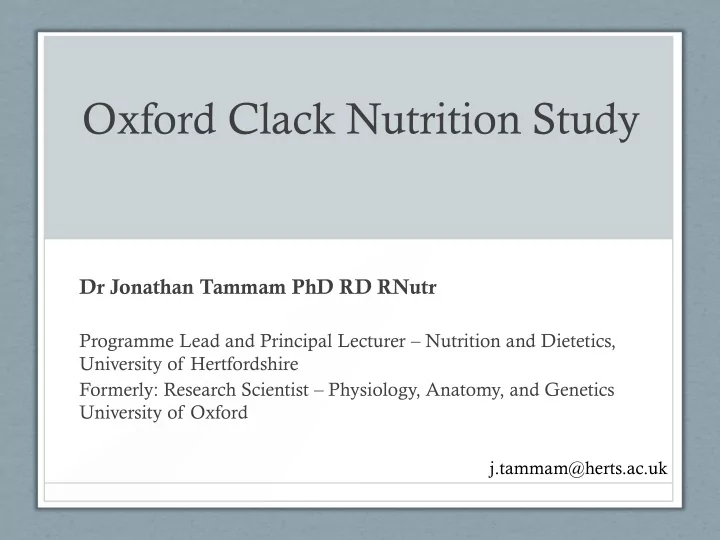

Oxford Clack Nutrition Study Dr Jonathan Tammam PhD RD RNutr Programme Lead and Principal Lecturer – Nutrition and Dietetics, University of Hertfordshire Formerly: Research Scientist – Physiology, Anatomy, and Genetics University of Oxford j.tammam@herts.ac.uk
Background – prisons
Background – ADHD
Background – schoolchildren
Rationale • Consistent evidence in correctional facilities • Heterogeneous study design and results in adolescents • Balance of evidence suggestive that multi-nutrient approach needed • Nutrition surveys • lower SES poorer diets – micronutrient deficiencies • n3 from oily fish – low intakes
Disadvantaged children have very low omega 3 levels (DOLAB trial) Omega 3 level should be at least 8% Acknowledgement Prof J Stein
Low n3/high n6 diet Acknowledgement Prof J Stein
Fish diet • Our brains could grow larger because our main food source was fish • In particular, fish supplied the omega-3, Docosahexanoic acid (DHA) together with many vital vitamins and minerals • Our brains contain 5g of DHA because it is an essential constituent of nerve membranes • Yet the average teenager eats no oily fish and eats far too much omega 6 which competes for the same enzymes Acknowledgement Prof J Stein
Robert Clack School
Demographics • 56% BME • 22% adult population unemployed • 34% children classified as living in poverty • 42% children from lone parent families • 40% children eligible for FSM
Clinical trial – participant flow
Clinical trial – supplements Supplement contains • Vitamins • Minerals • Omega 3 fish oils • EPA • DHA (Wellteen,Vitabiotics)
Clinical trial – Conners scale
Clinical trial – School records • • Behaviour Attendance • • Attitude Punctuality • • Fighting Rudeness • • Language Late • • Underperformance Illness • • Uniform Pastoral/Investigation • • Homework Truancy • • Class work Other
BJN paper
Results – nutrient status
Results – nutrient status
Results – behaviour (Conners)
Results – behaviour (School records) Misbehaviour 60% 40% 20% 0% All Low (<3) High (>3) -20% -40% -60% n=196 n=171 n=25
Conclusions – nutritional status Teenagers have low levels of n3 and several other • micronutrients • Pupils had very low baseline levels of EPA/DHA • Consistent with low intake of foods containing n3 • Consistent with NDNS n3 index improved but still <8% • All micronutrients measured were low baseline and • increased following supplementation. • Plasma concentrations of folate, vitamin C and vitamin D increased significantly.
Conclusions – behaviour • EPA, DHA, and other micronutrient status can be improved upon supplementation. • Increasing levels may reduce misbehaviour Recent study shows increased DHA associated with improved • parent-rated behaviour (Australia/ADHD) • Improved nutrition may translate to improved behaviour in those with high misbehaviour rates
Conclusions -behaviour • Supplements have protective effect against worsening behaviour (Conners) • Potential large treatment effects in children with high misbehaviour (School database) • Consistent with recent lab-based study measuring impulsivity and aggression • Statistically significant but caution re small sub-sample • These findings should now be replicated in larger studies
Dietary intake – Eatwell
Dietary intake – participants Hagger, Stein, and Tammam (2016)
Dietary intake – participants • Fruit and Veg: • 1¼ per day (recommend 5 per day or 1/3 of diet) • 2% of participants consumed none • Dairy: • 70% of participants inadequate intake to meet Ca RNI • 5% of participants consumed no dairy • Oily fish: • 7.2g/wk (NDNS 11g/wk; recommend 140g/wk) • 39% participants consumed fish (tuna, f&c, fingers) Hagger, Stein, and Tammam (2016)
Impact • Potential social implications • Public health policy • Need for improvement in adolescent nutritional status by: - Supplementation - Dietary improvement
Acknowledgements • Funders – Esmée Fairbairn, DRT, IFBB • Robert Clack School – Staff and students • Vitabiotics Ltd – Wellteen supplements • Blood analysis – University of Stirling and MRC HNR • Research Assistants
Recommend
More recommend